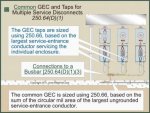inspector141
Senior Member
- Location
- Westminster, MD
In 250.64(D)(1), a common grounding electrode conductor must be sized based on the circular mil area of the largest service entrance conductor(s). However, there are some interpretations that this common grounding electrode conductor also applies to 250.66 (A)(B) and(C). That is, if your two service disconnects are supplied with 500kcmil service conductors for each service disconnect, you would need a min 2/0 to the concrete encased electrode based on Table 250.66 using 1000kcmil.
I do not believe this is correct. Just because 250.64 references the gec must be sized based on 250.66, does not mean you ignore 250.66 A,B & C. Also, 250.64 does not say use Table 250.66, it simply says to use 250.66.
For example, if you had a 2000 amp service disconnect with a concrete encased electrode, 250.66(B) only requires a #4cu gec.
However, if you had two 400 amp service disconnect switches (500kcmil)with a concrete encased electrode, according to some, a 2/0 would be required.
It's very clear if the grounding electrode is building steel or metal water pipe, then Table 250.66 must be used, but 250.66 A, B or C would still apply for multiple service disconnects.
I would like to know what other code professionals and experts think...
I do not believe this is correct. Just because 250.64 references the gec must be sized based on 250.66, does not mean you ignore 250.66 A,B & C. Also, 250.64 does not say use Table 250.66, it simply says to use 250.66.
For example, if you had a 2000 amp service disconnect with a concrete encased electrode, 250.66(B) only requires a #4cu gec.
However, if you had two 400 amp service disconnect switches (500kcmil)with a concrete encased electrode, according to some, a 2/0 would be required.
It's very clear if the grounding electrode is building steel or metal water pipe, then Table 250.66 must be used, but 250.66 A, B or C would still apply for multiple service disconnects.
I would like to know what other code professionals and experts think...


